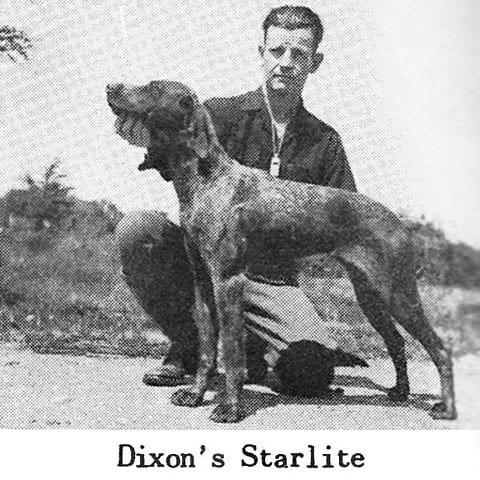

THE NGSPA: ITS EARLY YEARS
By: Don Kidd
While the general field trial fraternity would not be expected to know the history of the National German Shorthaired Pointer Association, Inc., (NGSPA), the sad truth is that many Shorthair field trial enthusiasts have little or no knowledge of the origins of this association. When German Shorthairs were first imported into the United States in 1925, they were originally promoted as an "everyuse" dog, a super-dog with some type of canine superiority. This type of exploitation may have induced some individuals to purchase dogs at inflated prices, but it did little to improve the breed. Fortunately, such elaborate promotion did not keep sincere breed enthusiasts from logically and sensibly endeavoring to bring out the true qualifications of the German Shorthaired Pointer.
Although limited in number, Shorthair field trial enthusiasts started to occasionally enter their breed in field trial competition. As early as 1931 a German Shorthair was braced with Mary Blue in an All-Age event soon after this Teagle Pointer had won the National Championship at Grand Junction, Tennessee. The majority of Shorthair field trialers, however, were content to run in shooting dog competition in stakes either for their own breed or in events judged along gun dog lines.
Ultimately, several factors converged to create the NGSPA and its affiliation with the American Field. Unlike today, there was an abundance of wild birds immediately following World War II. Young men who had fought in either the European or Pacific theaters returned home and started to again hunt upland game birds. Some of these men acquired German Shorthairs, field trials became an extension of their hunting experience, and the breed saw the development of its first professional handlers. Although field trial competition for the breed was increasing, several of these individuals were not satisfied with the Shorthair competition that was most readily available.
The typical field trial format was a walking trial run on a single course with a bird field. The emphasis was on a dog working in a windshield wiper pattern with extreme subservience to the gun. Since scouting was not allowed, there was little or no emphasis on the ability of a dog to independently select and run to logical objectives. Judges at the time frequently penalized a handler who attempted to sing to a dog that was reaching out on the course.
It was against this backdrop that knowledgeable amateur and professional handlers discussed the future of this breed in the late 1940's. These men frequently met after a trial and in huddled conversations discussed the need for field trial competition that offered the opportunity to test this breed under more natural conditions. These individuals were determined that the natural qualities of the breed—pointing, backing, and retrieving—should be retained while encouraging wider and faster moving dogs able to more effectively hunt upland game birds. These men also recognized that if American Field competition were available to their breed, it would expand their field trial opportunities.
While some men may dream and talk about what might be, there are other men that can lead. Every individual who has blown a whistle over a German Shorthaired Pointer in any type of field trial competition owes a debt of gratitude to a man most of them never knew existed. It was this individual who was almost solely responsible for the formation of the NGSPA, the first breed National Championship and, most important, the constant and continued development of the German Shorthaired Pointer as a bird dog.
Virgil Valdosta VanDivort was born on May 20, 1909, at Mansfield, Ohio, raised in Pennsylvania, spent his early life in Texas, and then returned to Toledo, Ohio, where he started work as an independent distributor for the Toledo Times, a newspaper which was then owned by the Toledo Blade. In 1947 VanDivort became an employee of the Times and over the years would hold positions as district manager in the circulation department, city circulation manager, and home delivery manager. VanDivort, on his employment application with the Times, described his hobbies as field trialing, bird dogs, riding horses, photography, fly fishing and almost any kind of bird shooting.
VanDivort was an excellent horseman and was quite knowledgeable of pointer-setter trials, having ridden the major circuit trials on several occasions. In keeping with his interests, he would operate a commercial kennel, judge all types of pointing dog competition, and frequently acknowledge that his first love was bird dogs. Lou Campbell, a sports writer for the Toledo Times, became a close friend and on occasion VanDivort would write an article for Campbell's Waters and Woods newspaper section.
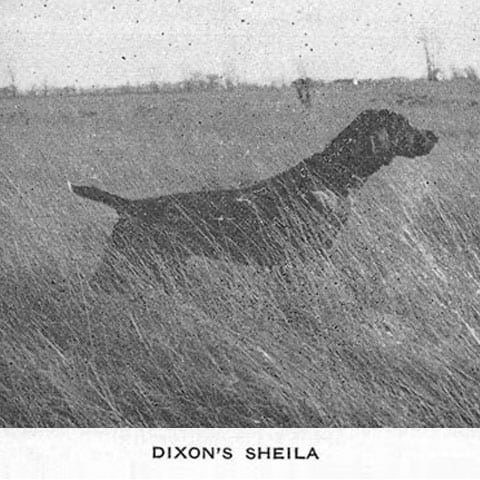

VanDivort's passion for hunting, bird dogs, and field trials, along with his association with the newspaper business, led him into contact with William F. Brown who was then editor of The American Field. It was through this association that the idea of the National German Shorthaired Pointer Association, Inc., was born. VanDivort was a member of the old Toledo German Shorthaired Pointer Club. In this era there were a great number of pheasants in the Toledo area, and the Toledo club had a large and active membership. After hunting season was over, the members would run dogs on the weekend and would then gather together at their clubhouse located on Rancamp Road for cookouts, parties, and other social activities. Paul Sharp, a bulk distributor for City Services Gasoline, who would serve as the first president of the NGSPA of Toledo and VanDivort, the first club secretary, would utilize the existing Toledo club membership as a basis for an American Field club. The original constitution and by-laws for the National German Shorthaired Pointer Club of Toledo were modeled after those of the Amateur Field Trial Clubs of America and were written in Paul Sharp's office in 1951 at the club's first meeting. This NGSPA club would be soon followed by the Defiance NGSPA and the Tri-City NGSPA, consisting of individuals from Saignaw, Bay City, and Midland, Michigan.
In 1952 these three clubs conducted the American Field sanctioned Mid-Western Open Challenge Stake. The Challenge Stake was the first American Field German Shorthaired Pointer all-age stake ever run in the United States that had a $500.00 guaranteed purse. The trial attracted 14 entries, was run on the club grounds of the old Toledo club in November 1952, and was judged by Dr. Richard Jackson of Toledo, Ohio, and R.L. "Cap" Mulder of Worthington, Ohio. Fritz Condon, owned and handled by Fred Condon of Toledo, Ohio, took first place in the trial. Russell "Lefty" Dixon, who was then operating out of St. Clair Shores, Michigan, garnered second with Dixon's Skiddoo, and Al Summers of Detroit, Michigan, captured third with Dixon's Starlite II. This stake fulfilled The American Field requirements that the sponsoring clubs had proven their knowledge and ability to stage a classic type trial and attract dogs worthy of running in such an event. This trial set the stage for the first NGSPA Championship.
A significant factor in the success of any field trial is adequate grounds to show a bird dog. In 1952 the Ohio Department of Natural Resources began the purchase of a natural basin of prairie in Wyandot and Marion Counties. This land acquisition would eventually grow to 8,627 acres and be known as the Killdeer Plains Wildlife Area. The October 24, 1953, issue of The American Field proclaimed that the National German Shorthaired Pointer Association was running its First National Championship Stake for German Shorthaired Pointers on November 14 and 15, 1953, over 6,000 acres of wonderful cover with an abundance of game birds. This inaugural NGSPA National Championship would be the third field trial run on these now famous grounds, the first continuous course trial ever held at Kildeer Plains, and the first bird dog field trial championship at this venue.
A total of 14 dogs went to the line in this first NGSPA Championship, which was judged by Dr. Richard W. Jackson of Toledo, Ohio, and G. Fred Hill of Crooksville, Ohio. Kildeer Plains, this November 1953, was extremely dry, and Ohio had unreasonably warm weather. Del Schmeltz, a local area professional trainer, and V.V. VanDivort had laid out five one-hour courses. C.L. "Kip" Kiple brought horses from Toledo mainly for the judges and a few guests. A number of handlers walked and this practice would be followed for almost ten years. Since there were no facilities on the grounds, a portable power generator had been brought in to help Ann VanDivort prepare lunches. On Saturday, November 14, 1953, the NGSPA hosted the first of many subsequent dinners at the Evergreens near Upper Sandusky, Ohio.
Dixon's Shelia had the class race of the stake—forward, and finishing strong but birdless. Dixon Star Lite II put down a good forward pattern with one find, a stop to flush, and a nonproductive. Hauptman v Dusseldorf's race was excellent for 45 minutes, but he had to be pushed to finish the hour. Hauptman had a stop at command on a bracemate's bump, a stop to flush, and one well-established stylish find. Dixon's Skiddoo scored early with one well-handled find, three stops to flush, and one nonproductive. Skiddoo ran a level race but lacked the punch and drive that was expected. There were dogs that lacked range, dogs with erratic races, and dogs that pushed wild birds into the air. On occasion, the flush of several pheasants at one time caused dogs to forget their manners.
At the conclusion of the trial, Dixon's Shelia was called back for another effort. She lacked the drive that carried her the day before and when the opportunity came on birds she did not take advantage of it. Four dogs were then called back to test their retrieving ability. Dixon's Star Lite II completed the land retrieve but failed to retrieve from water. Hauptman v Dusseldorf refused the land retrieve. Dixon's Skiddoo, while a bit slow in picking up the birds, made an acceptable delivery of the bird in both land and water tests. Max v Schulenberg marked his bird down well, retrieved smartly from land and water, but dropped his bird just short of the handler's hand.
In the first NGSPA Championship the title was withheld. Dixon's Skiddoo, dog, 485084, by Meadow v Reichenberg—Dixon's Star Lite, owned and handled by Lefty Dixon of St. Clair Shores, Michigan, was named the stake winner. Max v Schulenberg, 505602, dog, by Count vd Schulenberg—Kathryn v Sievers, owned and handled by Henry F. Weiss of Toledo, Ohio, was named runner-up. Virgil V. VanDivort vowed that the Championship would return next year and no one should doubt that the NGSPA would demand a Championship performance before one would be named.
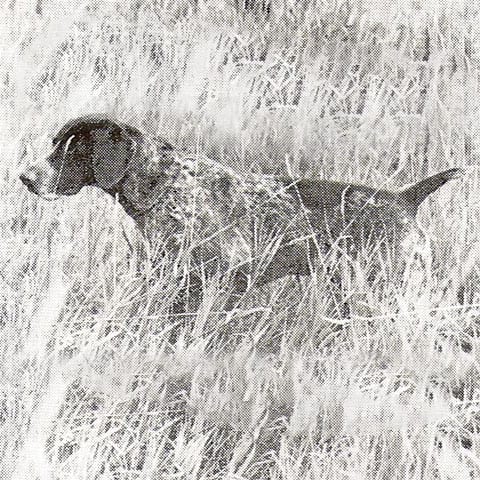
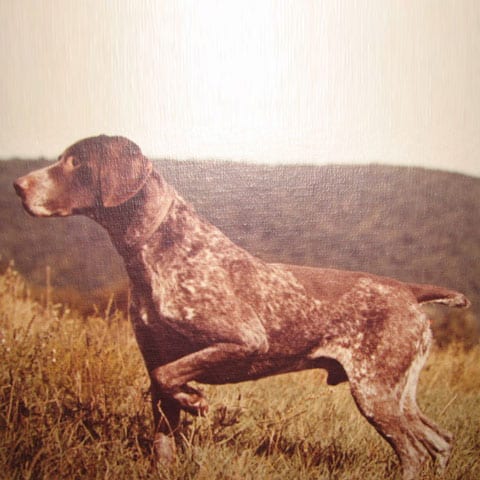

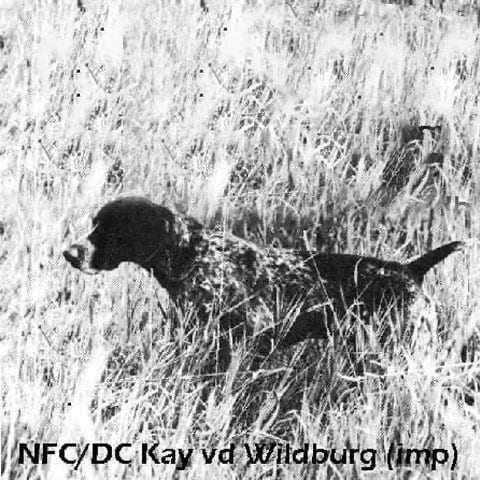

On April 28, 1954, the NGSPA incorporated as not-for-profit corporation in the State of Ohio. While authorized to do business in other states, Toledo, Ohio, still remains the principal place of business of the NGSPA. Paul L. Sharp, was the first president, and Virgil V. VanDivort was the initial secretary of the NGSPA. Henry L. Weiss, who owned and operated a baking company in the Toledo area, served as vice-president, and Leonard Hansen, the fire chief at an army ordinance depot near Toledo, Ohio, served as treasurer. The initial board of directors consisted of the foregoing individuals along with Paul Radde, James Baker, Gilbert Cross, Mahlon Tibbitts, Oscar VandenBosch, Martin Walter, H.G. Hogle, Dan Thornton, Charles Rogers, George Reimlinger, and William Wooten. A total of 114 individuals signed on as initial charter members including several that would make significant contributions to this organization.
On November 6, 1954, a total of ten dogs went to the line to compete for the second NGSPA Championship. VanDivort was concerned about the small entry and the way that the Shorthair fancier viewed this trial. In his article in the American Field VanDivort wrote words that have served as a guidepost for the NGSPA: "It was a distinct departure from the usual one-course trial and in the minds of these officers the only true test of a bird dog. We can watch all the work in the world on planted or just-released pen-raised birds and we'll never determine what the average dog owner wants to know about the breed; that is, the dog's ability to perform as a hunting dog."
After running an excellent race through any and all likely objectives, Fritz v Strauss emerged as the first NGSPA National Champion. Fritz's bracemate at 11 minutes worked a bird to the end of a feed strip where it flushed wild. Frtiz stopped. At 16 minutes Fritz backed his bracemate on a wild covey find. At 20 minutes both dogs were on point in the same area, but birds were not produced. At 22 minutes Fritz had a find with manners all in order at the shot. Fritz was sent on, took one step, and stopped. Two more birds rose in front of him with manners still in order. At 40 minutes Fritz found and handled a covey of quail with excellent deportment. At 48 minutes both dogs encountered several wild flushing pheasants in a feeder strip. Both dogs stood during several flushes and shots with Murdock alone flushing seven birds with no more than two rising at one time. In the second series, consisting of only a land retrieve, Fritz handled his retrieve in a credible manner. Dixon's Shelia had run a strong first hour with a good pattern which resulted in four solid finds and one stop to flush. Shelia performed well in the second series proving her ability during the shot, kill, and retrieve.
Fritz v Strauss, 512073, dog, by Otto v. Strauss-Ritz's Coco, owned by Carl Kemritz and handled by Joe Murdock, a retired engineer turned dog trainer of Downers Grove, Illinois, was declared the first NGSPA National Champion on November 6, 1954. The owner, Carl Kemritz, an Eastern airline pilot, was originally from Toledo, Ohio, but was then residing in Evergreen Park, Illinois. Kemritz, who liked to hunt upland birds, had been introduced to the breed by VanDivort. Dixon's Shelia, bitch, 509521, by Max v Schulenberg-Dixon's Star Lite, owned and handled by Lefty Dixon was named runner-up. On December 8, 1956, Vitality Dry Dog Food would run an advertisement featuring Fritz v. Strauss on the cover page of The American Field, the first of his breed to appear there.
The third NGSPA Championship was held on November 12, 1955, at Kildeer Plains Wildlife Area, again with an entry of only 10 dogs. VanDivort wrote in The American Field, dated December 31, 1955, at page 755 that the entry of ten dogs drawn to start was disappointing but the stake lacked nothing in quality. More dogs could have been obtained from a couple of sources, but they would have added nothing except numbers to the trial. But, this apparent lack of interest by breeders and trainers gave the officers of the organization cause to stop and ponder whether or not their efforts were worth it.
The trial was blessed with wonderful weather, and the courses for the most part were excellent. While the cover was too high in certain areas, the Ohio Division of Wildlife had established an excellent program of pheasant propagation that was ensuring an adequate supply of game birds for hunters as well as those who were utilizing the grounds for field trial activity.
Dixon's Sheila, owned and handled by professional Lefty Dixon of New Haven, Michigan, was awarded the Championship with "a sparking ground heat during which she really poured on the coal in her search for game." The course she had drawn was not the best, but she had opportunities on birds and her manners and style were exemplary at all times. Cast off at 2:05 she hit pay dirt in 11 minutes with a solid find. At 35 minutes she was out of ken for eight minutes. At 46 minutes she was observed working on a running pheasant, which got too near one of the horses and flushed. The dog stopped and remained until the command was given. Two minutes later Sheila backed her bracemate who was on point in a fencerow. Before the handlers could get in, the birds flushed with both dogs displaying good manners. Sheila was braced with Tell v Pinecrest, owned and handled by James Baker of Toledo, Ohio. Tell had a find at nine, the location of the covey of quail, and a find in a fencerow at 55.
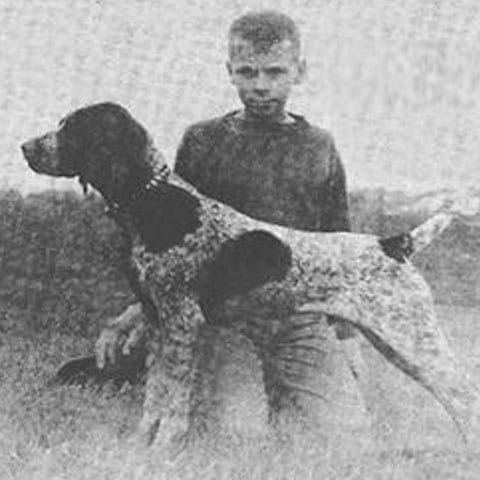

Dixon's Sheila, Tell v Pinecrest, Kay Starr, and Dixon's Skiddoo were called back for a second series. Sheila and Kay Star were braced together and Sheila honored Starr on an unproductive. Sheila then scored on two birds, which she retrieved smartly when sent. On her second point, Starr refused to honor, went by Sheila, and stole point. Tell and Skiddoo both pointed, backed, and retrieved in the second series, but Tell's first series ground heat gave him the nod. Judges G. Fred Hill of Crooksville, Ohio, and James C. Tallmadge of Jeromesville, Ohio, named Sheila the Champion and Tell v Pinecrest, dog, 513037 by Max v Schulenberg—Vesta v Maribeth, runner-up.
After the running a meeting of the NGSPA was held at the Evergreens in Upper Sandusky, Ohio. Martin Walter of Defiance, Ohio, was named president, Earl Cutler of Reese, Michigan, was elected vice-president, Virgil V. VanDivort was again named secretary, and Mahlon Tibbitts of Toledo was elected treasurer. While the future of the NGSPA and its Championship seemed uncertain, these officers vowed to continue with a trial that would prove the worth of this breed as a bird dog.
The fourth annual NGSPA Championship was held on November 10-11, 1956. Much of the Killdeer Plains Wildlife Area, again dry with wide cracks that had opened in the black earth, had become unusable because of high heavy weed growth that had taken over the fields. Ohio had a dry autumn with a 40-day drought, causing the cat-tails and bull thistle to rattle as a dog moved through the cover. However, Len Hansen, Whit LeMay, and Virgil VanDivort were still able to lay out three one-hour courses. A total of 18 dogs were entered in the championship which was judged by Richard S. Johns of Benton, Pennsylvania, and Lee G. Vollrath of Findlay, Ohio. Edward Van Tassel, Jim Baker, Virgil VanDivort, and Ed Haughn, and the NGSPA trustees, were enthusiastic about an increased interest in the trial.
In the first one-hour series Dixon's Sheila had run an enthusiastic race and was found on point by Judge Johns. She remained high and steady for Dixon's flush and shot. Lotte v. Heidelberg, running in the first brace, had a stop to flush at 11. From then on Lotte was a little hard to control but scored another find before the end of the hour with manners in order. A total of eight dogs were called back for the second series in a bird field. Dixon's Sheila cleaned the birdfield with three finds and two retrieves with one bird being missed. Lotte v. Heidelberg had two finds. On the first she moved just a bit and was whoaed, causing her to be slow to retrieve. On the second bird she did not move a hair and made a snappy return of the bird. These were the only two dogs that came through the second series without serious error.
As Sheila lacked the opportunity to honor, a dog was placed on point on a planted bird. Dixon cut Sheila away about 75 yards away from the dog on point. Sheila immediately backed upon observing the pointing dog. It was a worthy performance for the defending champion. Dixon's Sheila, owned and handled by Lefty Dixon of New Haven, Michigan, was again named the winner of the NGSPA Championship. Lotte v Heidelberg, handled by Joe Murdock, was named runner-up. Lotte, owned by Frank Vetter of Milwaukee, Wisconsin, was no stranger to field trial circles since Frank's father had previously entered her into field trial competition. After the senior Vetter died, his son, who had never seen her run, continued to campaign her—thus fulfilling the dog's promise.
Lefty Dixon, who also retired the first NGSPA rotating trophy with this his third win of the stake, was no stranger on the field trial circuit. Lefty was born and raised in the Dexter, Missouri, area and grew up quail hunting. Although of relatively small stature, Lefty was recruited to attend college at Louisiana State University to play football. His college gridiron career was cut short when it was learned that he had already played the sport professionally. Lefty then played baseball out of Popular Bluff, Missouri, pitching left handed for the old Southern League. In 1930 Lefty moved to Detroit, ostensibly to obtain employment with the United States Rubber Company but principally to play baseball for this corporation when such organizations placed a premium on company teams. World War II would find Dixon in the United States Army as a K-9 handler in the Pacific Theater.
After the war, Dixon would return to Detroit, Michigan, to work for his former employer. Dixon, as well as his father, were devoted quail hunters and his father bought Lefty a pointer and then a shorthair. The shorthair was registered as Dixon's Bell and would prove to be an outstanding hunting dog that would also have a great impact as a brood bitch. Her blood ran through many of the entries in the early years of the NGSPA Championship. Dixon turned professional in 1948 first operating his kennel out of St. Clair Shores and then, with the financial support of Henry F. Weiss, relocating to better facilities at New Haven, Michigan. Lefty, a tough competitor, was a strong supporter of the NGSPA.
In the first brace of the fifth renewal of the NGSPA Championship Kay Star, bitch, 547113 by Captain v Falkenhorst—Dixon's Star Lite II, owned and handled by Levi F. Summers of Detroit, Michigan, went away at 8:32 on October 9, 1957. Kay faced rugged conditions. Heavy rains on the previous day left some of the fields covered with water that had frozen into icy puddles through which dogs broke at every jump. Unless woods screened the course, the wind was a steady 30 to 40 miles per hour without letup.
Kay showed her mettle all the way. At 8:43 she swung off along a side road and found a pheasant where no bird really should have been on such a day. She pointed it with intensity and style to spare but took a couple of steps when the shot was fired. VanDivort reported that it would have been wrong to say she broke on this one as those two steps, perhaps made to better mark the flight, surely could not be construed as a break except by those who are just too narrow in their thinking. At 9:08 Kay had a mannerly stop on a bird which had been worked to a stop to flush by her bracemate. At 9:30 she again nailed a bird in a clump of weeds, and Summers went in to flush. The bird moved toward her and flushed near her head, but Kay remained steady. Kay's heady forward hour race set a standard for this stake.
Caudle's Leader, 550379, dog, by Dixon's Skiddoo—Ladie II, owned and handled by Edward B. Caudle, went to the post at 4:25 in the last brace on Saturday. Leader had a hard-driving race except for a couple of slow moments when he was trying to unravel some mystery of wind-scattered scent. At six minutes he had a stop to flush on a large bevy of quail. With the wind pouring across the backs of this brace, they topped a rise to see the birds leave. Leader was mannerly. At 4:38 he again stopped on the rise of one of the scattered coveys, and again the wind precluded any possibility of the dog handling the birds. At 4:57 all hands were searching heavy cover for Leader. He was discovered standing high and intent after Judge Johns had ridden up a bird. When Caudle approached, another bird rose in front of the dog and Leader was all manners at the shot. Leader also had an opportunity to stylishly back his bracemate on course.
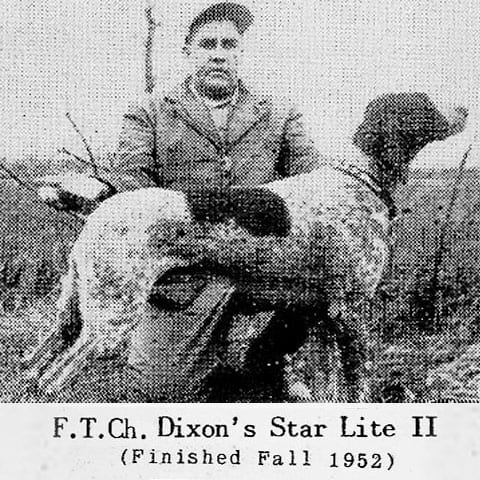

A total of six dogs were called back for the second series. The first brace consisted of Kay Star and Caudle's Leader, who had made the trip to Kildeer Plains in the same dog box. After a short back course to warm up, the dogs were brought into a large alfalfa field where birds had been planted. Kay went to a bird almost immediately and pointed positively and with lots of character. She needed no word during the flush and kill and made a good retrieve when sent, dropping the bird momentarily to get a better hold, before bringing it to hand. Leader nailed a bird at the edge of tall weeds and his retrieve was snappily executed and to hand. Marko Radbach v Lindenwald, Dixie v Heidebrink, Fritz of Sleepy Hollow, and Duke v Strauss all came through the second series with good manners.
A total of 20 dogs had been entered in this fifth renewal which was judged by Paul J. Teadway of Berkley, Michigan and Richard Johns. Kay Star was named the winner of this Championship, and Caudle's Leader was named runner-up. In winning this one, Kay recorded the first leg on the Ann VanDivort memorial trophy. Ann VanDivort had been a vital part of the early Championship trials at Kildeer Plains, preparing food and making coffee for the trial participants. She passed away on October 3, 1956, after an illness of two years. Virgil VanDivort had taken a poll to determine what type trophy would be most suitable and had commissioned Alfred Carl of Sylvania, Ohio, to execute one. When presented the trophy, tears appeared when Summers tried to say a few words of acceptance. Levi Summers, the first and one of the few amateurs to win this championship, was as gracious in victory as he had previously been in defeat.
Leonard Hansen again marshalled this stake. Jim Zander, George Roberts, Martin Walters, Bill Wooten, Jim Baker, Paul Radde, Eddie Haughn, and Virgil VanDivort lent hands wherever needed. These individuals were elated not only because of the success of this Championship, regarded as having many outstanding pieces of bird work by several dogs, but also because The American Field had given the NGSPA permission to run the first field futurity for German Shorthaired Pointers in 1958. Leonard Hansen was the first Futurity Manager but Paul Kile of the Defiance, Ohio, would shortly take over the futurity and run it for several years. The NGSPA's elected new officers were President, Eddie Haughn of Ridgeville Corners, Ohio; Vice-President, Frank Summers of Detroit, Michigan; Secretary, Virgil V. VanDivort, and Treasurer, Dr. Henry Fredericks of Cleveland, Ohio.
The Sixth NGSPA Championship was run on November 8-9, 1958, at Kildeer Plains Wildlife Area. Four one-hour courses were laid out which offered a variety of cover. The Ohio Division of Wildlife had been emphasizing a program of cover control and game management that was benefiting not only hunters but also field trialers. The weather was once more a significant factor in this trial for it was raw and windy during the running with spots of sleet and a great deal of rain. A high wind kept the birds more than unusually skittish, and the trial featured more than its share of unproductive points where handlers could not produce birds, which caused lengthy relocations and bumped birds.
A total of twenty dogs went to the line in this Championship judged by Richard Johns and Charles Hendricks. Dixon's Susie Q, 559152, bitch, by Dixon's Skiddoo—Audy Girl, owned by Howard F. Confer of Detroit, Michigan, and handled by Lefty Dixon was named Champion. Susie Q, who had taken top honors at the German Pointing Dog National Championship at Ohio, Illinois, the previous month, was described as the "new" type of German Shorthair in stature and build. She was streamlined, on the fine side, having good depth of chest, and standing up on her legs the way a dog should in order to move attractively and easily. She ran with a high head and moved into her birds without going to the ground. Susie showed the judges the type of race they wanted to see. She had a back on her bracemate's unproductive, a legitimate stop to flush with the wind across her back, and a solid pheasant find with manners all in order.
In the second series, consisting of a twenty minute back course ending in a bird field. Susie Q hunted her away around and climaxed her work with a solid find and good retrieve. Fritz v Strauss, the 1954 Champion, was named runner-up. In the first series Fritz had three well-handled pheasant finds and one creditable stop to flush, but his race had not measured up to what was expected in the stake. In the second series Fritz had a slow back course but hit his bird with style and made his retrieve properly.
A total of six dogs had been called back for the second series. VanDivort explained that in these call-backs the judges had to recall enough dogs to protect themselves in case the leading contenders failed to come through. However, if Susie Q and Fritz had not come through, he felt certain that no title would have been awarded.
Notwithstanding the elements, Eddie Haughn, Bill Wooten, Mart Walter, Jim Zander, George Roberts, Jim Baker, Dan Mast, Levi Summers and Ed Caudle did all sorts of jobs to ensure that this trial was a good one. The NGSPA officers elected for 1959 consisted of Eddie Haugh, president; Stanley Chiras, vice-president, Dr. H.H. Fredrick, treasurer; and Virgil V. VanDivort, secretary.
The 1959 NGSPA Championship would end the early years of this organization. Clubs from Cleveland, Toledo, and western Ohio along with the Golden Gate, Northern New York, Southern California, Michigan, and the Middle-Atlantic Regional Shorthair Club were now affiliated with the NGSPA. The one-hour stake run on wild birds was not only attracting more interest from field trial enthusiasts but was also influencing the manner in which professional handlers were having to develop their dogs. While the previous winners were the best of the breed, they were, in reality, only Shorthair shooting dogs. The Seventh NGSPA Championship would change that.
Kay V D Wilburg, dog, 571273, by Pol v Blitzdorf—Cora v Wesertor, was imported from Germany by Bodo S. Winterhelt of Port Colborne, Ontario, Canada, with money fronted by Walter Kogut of Brantford, Ontario, Candada. Winterhelt and Kogut were interested in a field trial dog, and this pup was not suitable for conditions in Germany because of his range. Winterhelt started working the dog, but Kogut obtained full title to Kay and placed him with Bill Bowers, a pointer-setter handler of Cross Junction, Virginia. Bowers not only placed this dog but also won with him in some pretty fast pointer-setter open derby competition. In the 1958 Championship, Kay, handled by Bowers, had started strong, had the class race of the stake, suffered an unproductive, and then took a bird—giving extended chase. Nevertheless, Kay was called back for the second series, had two unproductives on the backcourse, and did not find a bird. After this championship, Kogut would subsequently place the dog with Dick Johns who handled the dog to a pointer-setter open shooting dog placement as well as wins and placements in shorthair competition.
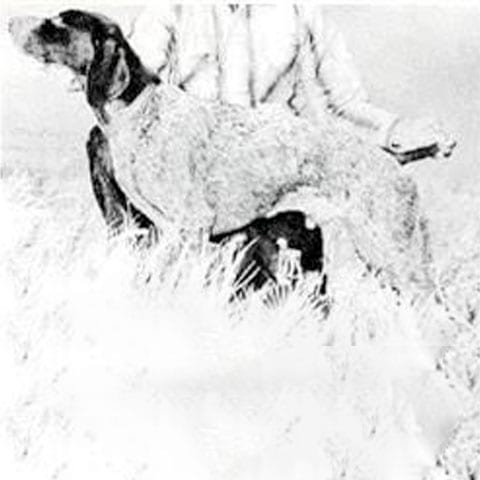

The Seventh NGSPA Championship was originally scheduled for two days, but a total of 33 dogs were entered in this stake with entries from Canada, Cuba, California, Washington, Virginia, Ohio, Michigan, Illinois, Kentucky, New York, Vermont, and Connecticut. The stake was again run at Killdeer Plains starting on October 30 and running through November 1. The grounds were in good condition, and the pheasant and quail populations were excellent on the four one-hour courses which had been laid out. Weather was excellent with sunshine and temperatures in the 50's and 60's. The trial was judged by G. Fred Hill of Crooksville, Ohio, and James C. Tallmadge of Jeromesville, Ohio.
Ed Haughn served as stake manager and received assistance from Henry and Edna Frederick, Martin Walter, Dan Mast, Len Hansen, Bill Wooten, and Fred Hunt. Curt Elarton had brought in a number of horses and VanDivort, who could not attend the trial for personal reasons, sent down his horses. At the annual NGSPA meeting, held at the Evergreens Restaurant, Edward Haughn was elected president, Dan Mast, first vice-president, Stanley Chiras was elected secretary, and Dr. H.H. Fredrick was elected treasuer. In addition, Don Briggs and Dick Johns were elected to the newly created positions of second vice-president and third vice-president, respectively.
Kay V D Wilburg was braced with Dixon's Sheila on the second day of the trial. Kay broke away at tremendous speed and started a cast down a woods line, reaching out to all likely objectives. Kay made eyes pop when he leaped a fence without breaking stride and shortly thereafter slammed into a stylish point. Johns produced three pheasants with Kay's manners exemplary. Johns led Kay a short distance away, and a minute later Kay pointed again with the handler having difficulty flushing the bird. Kay was sent on to relocate and as Kay pointed, Sheila, whose race had lacked the intensity of Kay's, bumped the pheasant. Kay then had an unproductive on a running pheasant. Kay went away running at exceptional range with long reaching strides cracking his tail up and down with each jump. Kay pointed again after time was called. A true shorthair all-age race had been witnessed, and those in attendance were well aware of the fact. Kay V D Wilburg had won this championship, and Stanley Chiras would write that Kay could wear this crown proudly.
Shenna v Feldstrom, the runner-up, bitch, 571273, by Ulk v d Radbach—Ginnie v Feldstrom, owned by Ed Caudle and Dr. Clark Lemley of Detroit, Michigan, and handled by Caudle, was braced with Skiddoo's Bee after lunch on the third day. This brace featured a large riding gallery taking advantage of sunshine and comfortable 55 degree weather. Bee jumped merrily at good range, pointed at three but then corrected. Sheena ran stylishly at good range, and applied herself well. Sheena pointed at 18 and had a beatiful relocation and displayed exemplary manners on a cock pheasant. Four minutes later Sheena was in motion as a pheasant took to the air beyond a corn feeder strip. Sheena stopped and a pair of pheasants then lifted. At 33 Bee had a stop to flush and Sheena backed. Sheena was found on point at 40 minutes and remained steady to wing and shot on the rooster. Sheena pointed again at 43 and was sent for a relocation. She made a big swing with head held high; as Sheena looped her turn back into the wind, a rooster flushed and she stopped. Sheena pointed again at 45 and was mannerly as the pheasant was produced. Sheena later had another legitimate stop to flush before the end of the hour.
A total of six dogs—Sergent v Dusseldorf, Sandra v Hohen Tann, Kay V D Wildburg, Riga v Hohen Tann, Sheena v Feldstrom, and Bobo Gradenbruch Beckum—were called back for the second series. While this series was originally deemed necessary to fulfill the requirements of the Championship, the NGSPA and its member clubs had decided the second series was somewhat artificial and were giving serious thought to the matter. Nevertheless, Kay went into the second series with tremendous drive, had a nice find in the birdfield, and remained mannerly. Kay was sent on the retrieve and he returned the bird merrily. Likewise, Sheena pinned a bird, exhibited perfect manners, and retrieved on command. The performance of both dogs had made them worthy of the title of NGSPA Champion and runner-up.
The two individuals who handled Kay and Sheena have been significant in the history of the NGSPA. Dick Johns, born and raised in Pennsylvania, was soon hunting grouse at an early age with bird dogs. As a young adult, Johns would be training bird dogs and horses for a living. World War II would find Johns with the United States Army in Europe. At the conclusion of the war, Johns was assigned to a horse cavalry unit with the task of locating dogs for pheasant hunting for senior officers. This role would acquaint him with the German Shorthaired Pointer, and he would import specimens of this breed to the United States upon his return. Johns would resume the training of hunting and field trial bird dogs near Benton, Pennsylvania, and would become an active professional handler competing with different breeds in both open pointer-setter and shorthair competition. Dick Johns actively promoted the NGSPA Championship by judging, competing and winning in this competition, and serving as an officer in this organization.
Edward Caudle, who handled Sheena, was born in Atkins, Arkansas, but his family subsequently relocated to Reeves, Missouri, and then to Caruth, Missouri, where they farmed to survive the depression. His early hunting experience was born of an economic necessity to help fill the family larder. World War II would find Caudle in the United States Marine Corps in the Pacific theater. Upon his discharge Caudle would return to Missouri, but he would soon relocate to Detroit, Michigan, to seek employment. He became a friend of Levi Summers and their hunting association led to Caudle's purchase of a German Shorthaired Pointer in 1949. This dog led him into a life as a professional handler when in 1952 he began operating a kennel and boarding operation out of Canton, Michigan. While not the first, Caudle was one of the early shorthair trainers who started taking this breed to the prairies for development. As a promoter of the breed, Caudle was a charter member of the NGSPA, worked at the early championship trials, served as a trustee for many years, and on two occasions presided as president of this association. His ideas about judges, judging, bird dogs, and the proper conduct of a class trial influenced many of the modern shorthair trainers more than they care to admit.
The NGSPA would now start a new era and many different individuals would come forward to participate in the Championship and work for this organization that has grown in strength and prestige. Like all field trial clubs, this association would experience the good times as well as the turbulent ones. Although the names of the dogs and the faces have changed, a debt of gratitude is owed to these early pioneers who wanted field trial competition that would realistically test this breed as a bird dog.
Joe Murdock, the handler of the first NGSPA Champion, would retire in Sarasota, Florida, but would remain active with shorthairs judging several Florida trials prior to his death. Lefty Dixon would retire to his winter headquarters, Ocala, Florida, in 1963 where he would enjoy quail hunting for several years. He died on December 31, 1995, in Rock Hill, South Carolina, the home of his stepson, Kenneth Johnston. This article could not have been written without the assistance of Ed Caudle of Canton, Michigan, Dick Johns of Benton, Pennsylvania, and Bill Wooten of Toledo, Ohio, also a charter member and former trustee of the NGSPA, all of whom still maintain an active interest in this organization. In addition, Barbara Teare and Gary Lockee of the Bird Dog Foundation in Grand Junction, Tennesee, were most gracious in helping my wife and myself locate and copy materials. The Foundation's growing collection of bird dog literature and memorabilia is invaluable to anyone attempting to research the history of field trials and its participants.
Virgil V. VanDivort, the individual most responsible for the National German Shorthaired Pointer Association and its championships, would be diagnosed with cancer. VanDivort had taken care of his first wife, Ann, for almost two years prior to her death from this same dreaded disease. In the last days prior to his death he would place telephone calls to or visit many of his field trial friends and express to them his appreciation for their friendship over the years. On January 10, 1968, VanDivort placed a telephone call to the Sheriff's Office in Toledo, Ohio. When a deputy sheriff responded, VanDivort's body was found. Dr. Harry Mignerey, a local coroner, ruled the death a suicide from a self-inflicted gunshot wound.
At the time of his death, VanDivort was active in many civic projects and fraternal orders, a member of the Outdoor Writers Association of America, and was still active in the affairs of the NGSPA. He had also served as vice president of the Ohio Field Trial Association and worked with some of his bird dog friends, who loved pheasant hunting, field trials, and Killdeer Plains, to create a stake that would develop into what came to be known as the International Pheasant Championship.
VanDivort has been quoted and misquoted about the NGSPA and his desire for this breed. He wrote in The American Field in 1954 at page 634 that "the thinking that went into the building of this stake was the result of a few persons with coinciding ideas about the Shorthair. We believed them to the capable of much more in the way of becoming bird dogs than we had seen demonstrated in many trials. We knew of and had the utmost faith in the nose of these dock-tailed imports. We knew, too, that they could be bred to have some of the drive, the bounce, the intensity in action through the fields and in their bird contacts that makes handling any bird dog a really thrilling experience even without a gun in one's hand. This we have attempted to do. We have not tried to do anything further."
